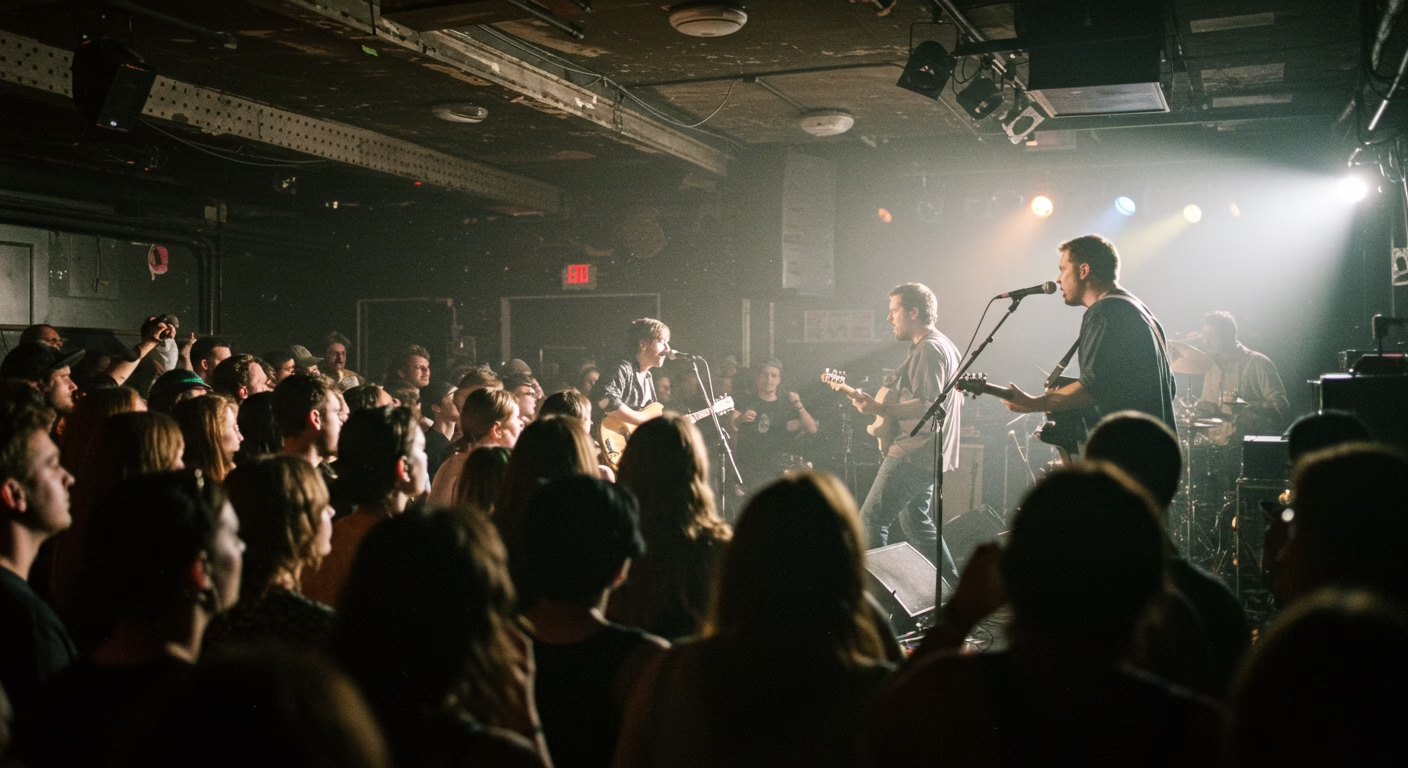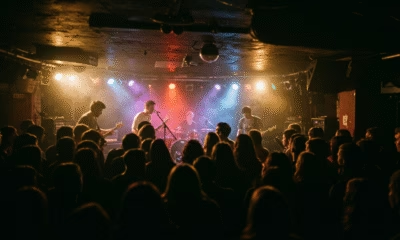BLOG
Live Music Today: Evolution, Challenges & Future

Live music has always been a cornerstone of human culture, serving as a powerful medium for storytelling, emotional expression, and communal bonding. In 2024, the live music industry is experiencing a dynamic transformation, shaped by technological advancements, shifting audience behaviors, and the lingering effects of the COVID-19 pandemic. From intimate club performances to massive music festivals, live music today is both thriving and adapting to new realities.
This article explores the current state of live music, examining key trends, challenges, and innovations that are redefining the experience for artists and audiences alike.
1. The Post-Pandemic Revival of Live Music
The COVID-19 pandemic brought the live music industry to a near standstill, with canceled tours, shuttered venues, and financial losses estimated in the billions. However, since the lifting of restrictions, live music has made a strong comeback.
A. The Surge in Demand for Live Experiences
-
Pent-up demand: After years of isolation, audiences are eager to reconnect with live performances.
-
Record-breaking tours: Artists like Taylor Swift, Beyoncé, and Harry Styles have embarked on massively successful tours, with tickets selling out within minutes.
-
Festival resurgence: Major festivals such as Coachella, Glastonbury, and Tomorrowland have returned with record attendance.
B. Challenges in the Recovery Process
-
Rising ticket prices: Inflation and high demand have led to increased costs, sometimes making live music inaccessible.
-
Venue closures: Many independent venues struggled to survive the pandemic, leading to a decline in grassroots music scenes.
-
Artist burnout: The pressure to tour relentlessly to recoup losses has led to concerns about musicians’ mental and physical health.
2. Technological Innovations Shaping Live Music
Technology continues to revolutionize how live music is produced, consumed, and monetized.
A. Virtual and Hybrid Concerts
-
Metaverse performances: Artists like Travis Scott and Ariana Grande have hosted virtual concerts in platforms like Fortnite and Roblox, attracting millions of digital attendees.
-
Livestreaming: Platforms like YouTube, Twitch, and Veeps allow artists to reach global audiences without physical tours.
B. Enhanced Fan Experiences
-
Augmented Reality (AR) and Virtual Reality (VR): Fans can now enjoy immersive concert experiences from home.
-
AI-powered interactions: Some artists use AI to create personalized fan experiences, such as AI-generated setlists or holographic performances (e.g., ABBA’s “Voyage” show).
C. Blockchain and NFTs in Live Music
-
Tokenized tickets: Blockchain ensures secure, resale-proof ticketing.
-
NFT collectibles: Fans can purchase exclusive digital merchandise or VIP experiences tied to live events.
3. The Changing Economics of Live Music
The financial landscape of live music has shifted, with artists and promoters exploring new revenue streams.
A. The Decline of Traditional Record Sales
-
With streaming dominating music consumption, live performances have become the primary income source for many artists.
B. Dynamic Pricing and Secondary Markets
-
Surge pricing: Platforms like Ticketmaster use dynamic pricing, leading to fluctuating ticket costs.
-
Resale markets: Scalping remains a problem, though some artists (e.g., Ed Sheeran) have implemented fan-first ticketing policies.
C. Diversification of Revenue
-
Merchandising: Artists now offer exclusive tour merch, vinyl records, and limited-edition items.
-
VIP experiences: Meet-and-greets, backstage passes, and premium seating add significant revenue.
4. Sustainability and Ethical Concerns in Live Music
As climate change becomes a pressing issue, the live music industry faces scrutiny over its environmental impact.
A. The Carbon Footprint of Tours
-
Transportation emissions: Large-scale tours contribute significantly to CO₂ emissions.
-
Waste generation: Festivals produce tons of plastic waste, food waste, and discarded gear.
B. Steps Toward Greener Concerts
-
Carbon-neutral tours: Artists like Coldplay and Billie Eilish have committed to sustainable touring practices.
-
Eco-friendly festivals: Events like Boom Festival (Portugal) prioritize renewable energy and zero-waste policies.
C. Ethical Considerations
-
Fair pay for artists: Many opening acts and smaller musicians struggle with low compensation.
-
Safe and inclusive spaces: Movements like #MeToo and Black Lives Matter have pushed for better backstage policies and diversity in lineups.
5. The Future of Live Music
What does the future hold for live music? Several trends suggest an exciting, albeit uncertain, path forward.
A. The Rise of Niche and Local Scenes
-
Community-driven shows: Smaller, independent venues are fostering local talent.
-
Genre-specific festivals: Events catering to niche audiences (e.g., K-pop, Afrobeat, hyperpop) are gaining traction.
B. Integration of AI and Machine Learning
-
AI-generated music: Some performances may incorporate AI-assisted compositions.
-
Smart venues: AI could optimize sound engineering, crowd control, and security.
C. The Continued Blurring of Physical and Digital
-
Hybrid events: Combining in-person and virtual elements will become standard.
-
Interactive concerts: Fans may influence performances in real-time via apps or social media.
FAQs About “Live Music Today: Evolution, Challenges & Future”
1. Is live music dying—or just evolving?
Answer: Far from dying, live music is transforming! While traditional venues face challenges, innovations like virtual concerts, immersive experiences, and hybrid events are reshaping the industry. The essence of live music remains, but how we experience it is changing.
2. Can TikTok and streaming replace the thrill of live concerts?
Answer: Nothing beats the electric energy of a live crowd! While streaming and short clips boost discovery, they fuel demand for real-life shows. Artists now use digital platforms to drive fans to live experiences—proving that tech enhances, not replaces, live music.
3. Why are concert tickets so expensive now?
Answer: Blame dynamic pricing, high demand, and rising production costs. But underground scenes, indie venues, and fan-first ticketing models are fighting back—so live music isn’t just for the wealthy!
4. Will AI replace live musicians in the future?
Answer: AI can compose and even mimic performances, but raw human emotion and spontaneity? Unbeatable. Expect AI to be a tool (like backing tracks or digital effects), not a replacement for real artists.
5. How are festivals surviving in the age of short attention spans?
Answer: By becoming full-blown experiences—think interactive art, wellness zones, and niche themes. Festivals now compete with Instagram moments, not just music!
6. What’s the next big trend in live music?
Answer: Think hologram tours, VR mosh pits, and intimate “secret” gigs. The future blends high-tech spectacle with ultra-personalized fan connections.
7. Can small artists still make it in today’s live music scene?
Answer: Absolutely! Social media and direct fan support (like Patreon) let indie artists thrive without big labels. House shows, DIY tours, and livestreams are the new launchpads.
8. Is the “album tour” model dead?
Answer: Not dead—but evolving. Artists now mix album tours with pop-up events, acoustic sessions, and fan meetups to keep engagement fresh.
9. How is sustainability changing live music?
Answer: From solar-powered stages to zero-waste festivals, the industry is going green. Fans and artists alike demand eco-friendly options—sustainability is now a headline act!
10. What’s the wildest future possibility for live music?
Answer: Brainwave-connected concerts where the crowd’s emotions shape the music in real-time. Sci-fi? Maybe. But with neurotech advancing, who knows?
Conclusion
Live music in 2024 thrives as a dynamic force of cultural connection, yet it navigates a landscape reshaped by post-pandemic realities and emerging complexities. While the industry has largely recovered from the disruptions of the early 2020s, its revival has been marked by adaptation rather than a return to the past. Escalating costs—from venue operations to artist fees and ticket prices—loom as a pressing challenge, pricing out some audiences and straining smaller venues. Sustainability has also moved to the forefront, with fans and artists alike demanding eco-conscious practices, from carbon-neutral tours to biodegradable stage materials and waste-reduction initiatives.
Meanwhile, technology’s rapid integration continues to redefine the concert experience. Augmented reality (AR) stages, AI-driven set designs, and holographic performances now coexist with traditional shows, offering immersive alternatives that blur physical and digital boundaries. Livestreams, once a pandemic lifeline, have evolved into polished, revenue-generating extensions of live events, democratizing access for global audiences.
Yet, amid these shifts, live music’s irreplaceable magic endures. Crowds still gather in shared euphoria, whether at intimate indie gigs or sprawling festivals, proving that human connection remains the heartbeat of the art form. Artists experiment with hybrid formats—live albums recorded in VR environments, blockchain-based fan interactions—yet prioritize raw, unfiltered moments onstage.
As artists and audiences adapt to these shifts, one thing is certain: live music will continue to thrive, innovate, and captivate generations to come. Whether in a packed stadium or a virtual metaverse, the magic of a live performance endures.
BLOG
Teenthailand_11_SC1: Unveiling Thailand’s Youth Culture

Thailand, a country renowned for its vibrant culture, stunning landscapes, and rich history, is also home to a dynamic and ever-evolving youth culture. Among the many facets of this culture, one term that has recently gained traction is “Teenthailand_11_SC1.” While the exact origins and meaning of this term may be shrouded in mystery, it appears to be a nod to the unique identity, trends, and experiences of Thailand’s younger generation. This article delves into the essence of Teenthailand_11_SC1, exploring its significance, the trends it represents, and its impact on Thai society.
The Rise of Teenthailand_11_SC1
The term “Teenthailand_11_SC1” seems to encapsulate a specific segment of Thailand’s youth culture, possibly tied to a particular event, movement, or online community. The inclusion of “11” and “SC1” suggests a coded or niche reference, perhaps linked to a school, a social media group, or a cultural phenomenon. While the exact meaning remains elusive, it is clear that Teenthailand_11_SC1 resonates with young Thais who are navigating the complexities of modern life while staying rooted in their cultural heritage.
Thailand’s youth are known for their creativity, adaptability, and tech-savviness. They are the driving force behind many of the country’s emerging trends, from fashion and music to social activism and digital innovation. Teenthailand_11_SC1 appears to be a reflection of this energy, serving as a symbol of unity and identity for young people who are shaping the future of their nation.
The Influence of Social Media
One of the key factors behind the rise of terms like Teenthailand_11_SC1 is the pervasive influence of social media. Platforms like Instagram, TikTok, and Twitter have become virtual playgrounds for Thailand’s youth, allowing them to express themselves, connect with like-minded individuals, and showcase their creativity. Hashtags, challenges, and viral trends often originate from these platforms, and it is likely that Teenthailand_11_SC1 emerged in a similar fashion.
Social media has also given Thai youth a platform to address social issues and advocate for change. From environmental activism to calls for educational reform, young people are using their voices to challenge the status quo and push for a better future. Teenthailand_11_SC1 may be a rallying cry for this generation, symbolising their shared aspirations and determination to make a difference.
Fashion and Aesthetics
Fashion is another area where Teenthailand_11_SC1 seems to leave its mark. Thai youth are known for their eclectic and innovative sense of style, blending traditional elements with modern trends to create unique looks. Streetwear, vintage fashion, and DIY aesthetics are particularly popular, reflecting a desire to stand out and express individuality.
The term Teenthailand_11_SC1 could be associated with a specific fashion trend or subculture. For instance, it might represent a group of young people who embrace a particular aesthetic, such as retro-inspired outfits or futuristic designs. Alternatively, it could be linked to a local brand or designer that has gained a cult following among Thailand’s youth.
Music and Entertainment
Music is another cornerstone of Thai youth culture, and Teenthailand_11_SC1 may have ties to the country’s vibrant music scene. From indie bands and hip-hop artists to K-pop-inspired groups, Thailand’s music industry is diverse and constantly evolving. Young people are not only consumers of music but also active participants, forming bands, producing their own tracks, and sharing their work online.
The term Teenthailand_11_SC1 might be associated with a specific genre, artist, or music event. For example, it could refer to a concert series, a fan club, or a collaborative project that brings together young musicians and fans. Music has the power to unite people, and Teenthailand_11_SC1 could be a testament to the unifying force of sound and rhythm.
The Role of Education and Ambition
Education plays a significant role in the lives of Thai youth, and Teenthailand_11_SC1 may also reflect their aspirations and ambitions. Many young people in Thailand are striving to excel academically while pursuing their passions and interests. The term could symbolise the balance they seek between tradition and modernity, between their responsibilities and their dreams.
In recent years, there has been a growing emphasis on innovation and entrepreneurship among Thailand’s youth. Start-ups, creative projects, and social enterprises are on the rise, driven by young people who are eager to make their mark on the world. Teenthailand_11_SC1 might represent this spirit of innovation, serving as a reminder that the future belongs to those who dare to dream and take action.
Challenges and Resilience
While Teenthailand_11_SC1 embodies the energy and optimism of Thailand’s youth, it is important to acknowledge the challenges they face. Economic inequality, political instability, and environmental issues are just some of the obstacles that young people must navigate. Despite these challenges, they continue to demonstrate resilience and determination, finding ways to overcome adversity and create opportunities for themselves and others.
The term Teenthailand_11_SC1 could also be a symbol of this resilience, representing the strength and perseverance of a generation that refuses to be defined by its struggles. It is a reminder that even in the face of hardship, there is hope and the potential for positive change.
The Global Connection
Thailand’s youth are not isolated from the rest of the world; they are deeply connected to global trends and movements. Teenthailand_11_SC1 may reflect this global perspective, blending local traditions with international influences to create something uniquely Thai. Whether it’s through fashion, music, or social activism, young people in Thailand are making their voices heard on the global stage.
This connection to the wider world also means that Teenthailand_11_SC1 has the potential to inspire and influence youth beyond Thailand’s borders. As a symbol of creativity, resilience, and innovation, it could resonate with young people everywhere, fostering a sense of solidarity and shared purpose.
Conclusion
Teenthailand_11_SC1 is more than just a term; it is a reflection of the vibrant, dynamic, and multifaceted nature of Thailand’s youth culture. While its exact meaning may remain open to interpretation, it undoubtedly represents the creativity, ambition, and resilience of a generation that is shaping the future of their country. From social media and fashion to music and activism, Teenthailand_11_SC1 encapsulates the spirit of young Thais who are navigating the complexities of modern life while staying true to their roots.
As Thailand continues to evolve, so too will its youth culture. Terms like Teenthailand_11_SC1 serve as a reminder of the power of young people to drive change, inspire others, and create a better future. The youth of Thailand are proving they are a force to be reckoned with through art, innovation, and advocacy, and Teenthailand_11_SC1 stands as a testament to their enduring spirit.
BLOG
aajkitajikhabar.com: The Hindi Business News Leader

In today’s fast-changing digital media environment, aajkitajikhabar.com business has established itself as a prominent Hindi-language news platform while gradually expanding its influence across India’s competitive news sector. Originally launched to serve Hindi-speaking audiences, the platform has strategically evolved to become a comprehensive news source that delivers breaking updates alongside detailed business coverage.
What sets aajkitajikhabar.com business apart is its dual focus on immediacy and depth. While providing minute-by-minute news alerts, it simultaneously offers analytical pieces that help readers understand complex business developments. This balanced approach has attracted diverse demographics ranging from corporate professionals to retail investors seeking reliable market insights.
The platform’s business model cleverly combines multiple revenue streams. Alongside conventional digital advertising, it has developed premium subscription tiers offering exclusive content and early access to important reports. Furthermore, strategic partnerships with financial institutions have created additional monetization opportunities through sponsored content and co-branded research publications.
In terms of audience engagement, aajkitajikhabar.com business employs sophisticated data analytics to personalize content delivery while maintaining a clean, user-friendly interface optimized for mobile consumption. Regular interactive features like live Q&As with industry experts and reader polls foster community involvement and repeat visits.
Looking ahead, the platform appears well-positioned for growth as it explores AI-driven content recommendations and regional language expansions. However, challenges remain in differentiating itself in an increasingly crowded digital news market. By continuing to innovate while preserving its core commitment to quality Hindi business journalism, aajkitajikhabar.com business seems likely to strengthen its position as a trusted news source for India’s growing digital-native audience.
1. Overview of Aajkitajikhabar.com
Mission and Vision
Aajkitajikhabar.com, meaning “Today’s Latest News” in Hindi, was launched to provide reliable and timely news for Hindi-speaking audiences. Originally focused on general news, the platform gradually shifted its emphasis to business journalism. Consequently, it now specializes in finance, markets, and economic trends tailored for regional readers.
The website primarily serves as a bridge in Hindi business reporting, which was previously underserved. Additionally, it covers startup ecosystems and global developments while maintaining simple, accessible language. As a result, it has become a go-to source for professionals seeking local insights.
Initially starting with basic coverage, the platform has since expanded its content depth and variety. Moreover, it ensures complex financial topics are explained clearly. Therefore, even readers without formal economic training can benefit.
Looking ahead, the platform continues to evolve by incorporating reader feedback. Ultimately, its success lies in making business news both informative and approachable for its core audience.
Content Spectrum
The website covers a broad range of topics, including:
- Business & Finance: Stock market updates, corporate news, and economic policies.
- Technology: Innovations in AI, blockchain, and digital payments.
- Startups & Entrepreneurship: Funding news, success stories, and interviews with industry leaders.
- Global Economy: Trade agreements, inflation trends, and geopolitical impacts on markets.
Its localized approach, especially in covering regional business developments, sets it apart from English-dominated financial news platforms.
2. Business Model and Revenue Streams
Aajkitajikhabar.com operates on a multi-pronged monetization strategy, ensuring sustainability while keeping content free for users. Key revenue streams include:
Advertising Revenue
- Display Ads: Banner and sidebar ads generate income based on traffic volume.
- Programmatic Advertising: Automated ad placements optimize revenue through real-time bidding.
- Sponsored Content: Native ads blend seamlessly with editorial content, promoting brands without disrupting user experience.
Affiliate Marketing and Partnerships
- The platform earns commissions by promoting financial products, tech gadgets, or educational services via affiliate links.
- Collaborations with fintech firms and banks enhance credibility while driving revenue.
Guest Posts and Backlink Opportunities
- Businesses and thought leaders contribute guest articles, paying for exposure and SEO benefits through high-authority backlinks.
Future Monetization Avenues
- Subscription Models: Premium content or ad-free experiences could be introduced.
- Video and Podcasts: Diversifying into multimedia content to attract advertisers.
3. Content Strategy and SEO Excellence
Focus on Quality and Relevance
- Original Reporting: Unlike aggregators, aajkitajikhabar.com business invests in original journalism, ensuring depth and accuracy.
- Fact-Checking: Rigorous editorial processes combat misinformation, a critical edge in today’s media landscape.
SEO Optimization
- Keyword-Rich Headlines: Articles are tailored for search engines without compromising readability.
- Evergreen Content: Regular updates to older posts maintain SEO rankings.
- Multimedia Integration: Videos, infographics, and bullet points enhance engagement and dwell time.
Localized Global Coverage
- While covering international trends like IMF agreements or global market shifts, the platform contextualizes their impact on Indian businesses.
4. Audience Engagement and Community Building
Social Media Presence
- Active on Facebook, Twitter, and LinkedIn, the platform shares breaking news and fosters discussions, driving traffic back to the website.
Interactive Features
- Comment Sections: Readers debate and share opinions on articles.
- Newsletters: Daily or weekly digests keep subscribers informed.
Case Study: Startup Ecosystem Coverage
By spotlighting local entrepreneurs and funding trends, aajkitajikhabar.com business has built a loyal following among startups, offering them visibility and networking opportunities.
5. Challenges and Future Prospects
Challenges
- Competition: Competing with established English and regional news portals.
- Misinformation: Ensuring fact-checking scales with content volume.
Growth Opportunities
- Regional Expansion: Adding content in other Indian languages (e.g., Bengali, Tamil).
- AI and Personalization: Using AI to curate personalized news feeds.
- Video Content: Live market updates or expert interviews could attract younger audiences.
Conclusion
Aajkitajikhabar.com has established itself as a trusted name in Hindi business journalism by blending credibility with localized content. Initially, the platform focused on delivering accurate financial news, but over time, it expanded its coverage to include regional economic updates. Consequently, it has built a loyal readership among Hindi-speaking professionals.
One key factor behind its success is its reader-centric approach. Although it relies on advertisements, the platform ensures that user experience remains uncompromised. Moreover, its content strategy combines in-depth analysis with breaking news, making it a comprehensive resource. For instance, it covers everything from stock market trends to small business advice, thereby catering to diverse needs.
Looking ahead, the platform is well-positioned for growth. As digital media evolves, it must continue adapting to stay relevant. Specifically, integrating multimedia elements like videos and podcasts could enhance engagement. Similarly, leveraging AI for personalized content delivery might further strengthen its appeal.
Despite competition, aajkitajikhabar.com business stands out due to its commitment to quality. While other portals prioritize speed, this platform emphasizes accuracy and context. Furthermore, its focus on regional business developments fills a critical gap in Hindi journalism.
Ultimately, the website is more than just a news source—it serves as a strategic tool for professionals. By staying innovative and responsive to audience needs, it can sustain its leadership in Hindi business journalism. Therefore, for those seeking reliable economic insights, aajkitajikhabar.com remains an indispensable ally.
ART
SerpentRogue: The Art of Cunning Dominance

In the fast-paced world of competitive gaming, players are always looking for ways to outperform their rivals. Among the many strategies available, the competitive edge the serpentrogue stands out as a character that consistently provides a competitive edge. This agile and deceptive fighter dominates through speed, precision, and unpredictability across various game genres.
First and foremost, the competitive edge the serpentrogue comes from its unmatched mobility. It can swiftly engage and disengage, making it ideal for hit-and-run tactics. At the same time, its stealth mechanics allow for surprise attacks, keeping opponents on edge. That said, this playstyle isn’t without risks—its low defense means one wrong move can be costly.
Beyond raw mechanics, the competitive edge the serpentrogue shines in team play. When coordinated with allies, it can isolate and eliminate high-value targets with ease. On the other hand, solo players must rely on superior positioning and mind games to maintain pressure.
In MOBAs, the Serpent Rogue excels as a backline assassin, while in fighting games, its rapid combos create relentless pressure. Meanwhile, in RPGs, its ability to bypass defenses makes it invaluable for strategic plays.
Ultimately, mastering the competitive edge the serpentrogue requires patience and precision, but the payoff is undeniable. By leveraging its competitive edge, players can control the pace of matches and outmaneuver opponents with calculated aggression. Whether in solo or team settings, this deadly archetype remains a top choice for those seeking dominance through skill and strategy.
1. Defining the Serpent Rogue Playstyle
The Serpent Rogue is not just a character but a playstyle characterized by:
-
High Mobility – Quick dashes, teleports, and evasive maneuvers.
-
Stealth & Deception – Invisibility, feints, and misdirection.
-
Burst Damage – High-damage combos executed in short windows.
-
Fragility – Low health, requiring precise positioning.
This archetype is seen in games like League of Legends (e.g., Evelynn, Shaco), Street Fighter (e.g., Vega, Ibuki), and Dark Souls (e.g., dagger-wielding assassins). The Serpent Rogue excels in hit-and-run tactics, psychological pressure, and punishing mistakes.
2. Strengths of the Serpent Rogue
A. Unpredictability
The biggest advantage of a Serpent Rogue is their ability to keep opponents guessing. By utilizing stealth, fake-outs, and erratic movement, they force enemies into making mistakes.
-
Example: In Apex Legends, characters like Mirage use decoys to bait enemies into revealing their positions.
B. High Outplay Potential
Due to their mobility, Serpent Rogues can turn fights around even when outnumbered. A well-timed dodge or counter can dismantle an opponent’s strategy.
-
Example: In League of Legends, Zed’s shadow-swapping allows him to dodge key abilities while retaliating with lethal precision.
C. Psychological Dominance
The mere presence of a Serpent Rogue can tilt opponents. The fear of an ambush forces enemies to play defensively, giving the Rogue’s team map control.
-
Example: In Dota 2, Riki’s permanent invisibility forces enemies to invest in detection, delaying their core items.
3. Weaknesses and Counterplay
Despite their strengths, Serpent Rogues have exploitable flaws:
A. Squishiness
Most Serpent Rogues have low health, meaning one misstep can lead to instant death.
-
Counter: Focus fire, crowd control (CC), and area-of-effect (AoE) abilities can shut them down.
B. Reliance on Cooldowns
Their burst damage often depends on abilities with long cooldowns. If they fail a kill attempt, they become vulnerable.
-
Counter: Bait out their key skills before engaging.
C. Dependency on Snowballing
Many Serpent Rogues need early kills to stay relevant. If shut down early, they struggle to recover.
-
Counter: Deny them kills through vision control and defensive positioning.
4. Mastering the Serpent Rogue: Key Strategies
A. Vision Control
Since stealth is a core mechanic, controlling vision is crucial.
-
Warding: In MOBAs, place wards in flanking routes.
-
Deception: Use fake retreats to lure enemies into traps.
B. Target Selection
A Serpent Rogue must prioritize high-value targets (e.g., enemy carries, mages).
-
Assassination Priority:
-
Glass Cannons (e.g., ADCs, Mages)
-
Isolated Targets (split-pushers)
-
Low-Mobility Supports
-
C. Escape Routes
Always have an exit plan. Engage only when you know how to disengage.
-
Example: In Elden Ring, using Quick Step with a dagger allows hit-and-run tactics against bosses.
5. Serpent Rogues in Different Genres
A. MOBAs (League of Legends, Dota 2)
-
Best Picks: Evelynn, Shaco, Riki
-
Playstyle: Roam, gank, and disrupt the enemy backline.
B. Fighting Games (Street Fighter, Mortal Kombat)
-
Best Picks: Vega (Claw), Mileena, Ibuki
-
Playstyle: Mix-ups, cross-ups, and punishing whiffs.
C. RPGs (Dark Souls, Skyrim)
-
Best Builds: Daggers, poison, stealth archery.
-
Playstyle: Backstabs, ambushes, and hit-and-run tactics.
6. The Future of the Serpent Rogue in Esports
As games evolve, so does the Serpent Rogue archetype. Developers are introducing:
-
Advanced Stealth Mechanics (e.g., dynamic camouflage)
-
More Counterplay Options (e.g., true sight abilities)
-
Hybrid Playstyles (e.g., rogue-mage hybrids)
Players who adapt to these changes will continue to dominate with this playstyle.
Conclusion
In the dynamic arena of competitive gaming, the Serpent Rogue has emerged as a playstyle that demands both skill and strategic thinking. While challenging to master, this approach offers a significant competitive edge for players who embrace its high-risk, high-reward nature.
To begin with, the Serpent Rogue excels in unpredictable movement and precision strikes, creating constant pressure on opponents. However, this advantage comes with vulnerability, as the playstyle often sacrifices durability for mobility. Consequently, players must balance aggression with caution to maintain their competitive edge.
Moreover, what sets the Serpent Rogue apart is its adaptability. Whether facing tanky brawlers or ranged specialists, this playstyle can outmaneuver them through clever positioning. For instance, in team fights, the Serpent Rogue thrives by targeting high-priority enemies before retreating to safety. Meanwhile, in one-on-one encounters, its mix-up potential keeps adversaries guessing.
Additionally, mastering the Serpent Rogue requires understanding both its strengths and counterplay. On one hand, its speed and deception provide a clear competitive edge. On the other hand, opponents who predict its patterns can punish mistakes harshly. Therefore, players must constantly vary their tactics to stay unpredictable.
Furthermore, team coordination amplifies the Serpent Rogue’s effectiveness. While it can operate independently, communicating with allies maximizes its disruptive potential. Conversely, solo players must rely more heavily on mind games and precise execution to maintain their competitive edge.
Ultimately, the Serpent Rogue represents the pinnacle of skill-based gameplay. By combining creativity with razor-sharp precision, players can unlock its full potential and dominate matches. The true competitive edge lies not just in mechanical skill, but in the ability to think several steps ahead of the competition. For those willing to put in the practice, the Serpent Rogue offers one of the most rewarding playstyles in competitive gaming.
-

 EDUCATION4 months ago
EDUCATION4 months agoHCOOCH, CH₂, and H₂O: Key Molecules in Chemistry and Life
-

 BLOG2 months ago
BLOG2 months agoTeenthailand_11_SC1: Unveiling Thailand’s Youth Culture
-

 EDUCATION6 months ago
EDUCATION6 months agoQawerdehidom: Origins, Principles, and Modern Applications
-

 BLOG3 months ago
BLOG3 months agoTheapknews.shop Health: Your Gateway to Wellness and Tech
-

 ENTERTAINMENT3 months ago
ENTERTAINMENT3 months agoWhat Are Coachella Co-Chairs: The Visionaries Behind the Iconic Festival
-

 BLOG6 months ago
BLOG6 months agoPO18: A Comprehensive Guide to Its Meaning and Applications
-

 EDUCATION4 months ago
EDUCATION4 months agoNowCollege 1v1: Redefining Personalized Higher Education
-

 ENTERTAINMENT6 months ago
ENTERTAINMENT6 months agoKuttymovies7: A Comprehensive Look at the Controversial Movie Piracy Platform










